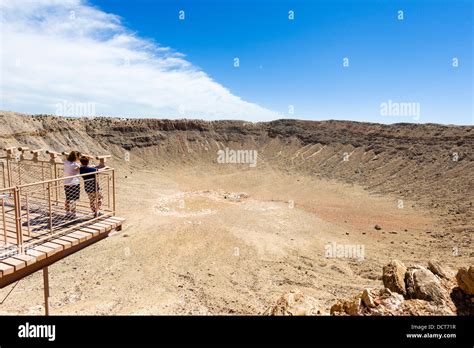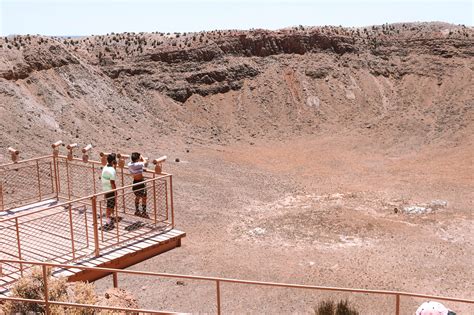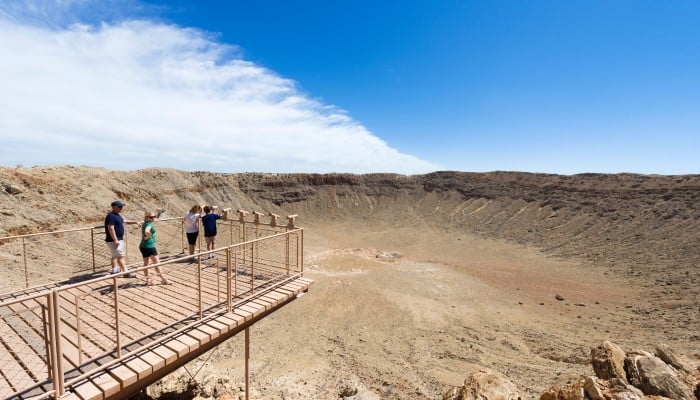Nestled in the Arizona desert, the Meteor Crater National Landmark stands as a testament to the Earth’s dynamic history. This colossal impact site, formed over 50,000 years ago by a meteorite collision, is not only a geological wonder but also a window into the past. Located just off Route 66, this well-preserved crater offers visitors a unique opportunity to explore a site of immense scientific and historical importance. From its dramatic formation to its role in advancing space research, Meteor Crater continues to captivate scientists, historians, and travelers alike. Discover the marvels of this natural landmark and the rich history it holds within its depths.
Dive deep into this topic alongside ritarblog.com
1. Location and Accessibility
Nestled in Northern Arizona, the Meteor Crater National Landmark is conveniently located approximately 37 miles east of Flagstaff and 18 miles west of Winslow. This prime location ensures easy accessibility from major highways, particularly Interstate 40. The crater itself sits just a short distance south of the legendary Route 66, adding a touch of historical allure to the journey. Visitors can effortlessly navigate their way to this natural marvel by following clearly marked signs leading to the entrance, making for a smooth and straightforward drive.
The nearest airport is Flagstaff Pulliam Airport, located about an hour’s drive from the site. For travelers arriving from Phoenix or Las Vegas, a scenic road trip of approximately 3-4 hours will take you directly to the crater. The landmark is open year-round, with hours of operation varying seasonally. Ample parking is available for cars, RVs, and buses.
Upon arrival, a visitor center offers comprehensive information and guidance, simplifying exploration of the area. The crater is wheelchair accessible, featuring ramps and pathways designed for all visitors. This blend of prime location and thoughtful amenities ensures Meteor Crater is a welcoming destination for travelers of all abilities.

2. Geological Significance
Meteor Crater National Landmark stands as a testament to Earth’s geological history, serving as one of the most well-preserved meteorite impact sites on the planet. Created around 50,000 years ago during the Pleistocene epoch, the crater resulted from the collision of a nickel-iron meteorite, approximately 160 feet in diameter, traveling at an astounding 26,000 miles per hour. The impact unleashed energy comparable to multiple nuclear explosions, carving out a crater nearly a mile wide and over 550 feet deep.
This site offers a unique opportunity to witness the powerful forces that have molded our planet’s surface. Unlike many other craters, which have been worn away or filled in by time, Meteor Crater’s dry climate has preserved its features in exceptional detail. The crater’s sharp edges and distinct layers of rock, including shifted limestone and sandstone, offer invaluable information about the mechanics of meteorite collisions.
Extensive scientific study of Meteor Crater has illuminated the consequences of celestial collisions, enriching our comprehension of planetary geology and impact events. This remarkable site remains a pivotal hub for geological research, attracting both professionals and amateur enthusiasts drawn to its exceptional formations.

3. Historical Discovery
Meteor Crater National Landmark stands as a testament to Earth’s geological history, serving as one of the best-preserved meteorite impact sites on our planet. Its formation dates back to the Pleistocene epoch, approximately 50,000 years ago, when a nickel-iron meteorite, measuring roughly 160 feet in diameter, struck Earth at an estimated velocity of 26,000 miles per hour. This colossal impact unleashed energy comparable to multiple nuclear detonations, carving a crater nearly a mile wide and exceeding 550 feet in depth.
This site provides a unique opportunity to observe the powerful forces that have molded our planet’s surface. Unlike many craters that have been worn down or filled in over time, Meteor Crater’s dry environment has kept its features remarkably intact. The crater’s sharp edges and clear layers of rock, including shifted limestone and sandstone, offer crucial information about the effects of meteorite collisions.
Extensive scientific study of Meteor Crater has yielded valuable insights into the effects of celestial collisions, advancing our understanding of planetary geology and impact events. This geological marvel remains a crucial site for research, attracting both experts and enthusiasts who are drawn to its distinctive formations.

4. Scientific Research and Findings
Since the early 20th century, Meteor Crater has been a hub for scientific exploration, greatly contributing to our knowledge of impact cratering and planetary science. One of the pioneering figures in the crater’s study was Daniel Barringer, a mining engineer who, in contrast to the prevailing belief of volcanic origins, proposed that the site was formed by a meteorite impact. Barringer’s research was instrumental in establishing the significance of impact events in Earth’s geological past.
Further research conducted at the site has yielded crucial information about the characteristics of meteorite impacts. Analysis of the crater’s composition revealed substantial concentrations of nickel and iron, substantiating its extraterrestrial origin. Moreover, the identification of shocked quartz and other impact-associated minerals at the site has further cemented its standing as a prime example of an impact structure.
During the 1960s, NASA employed Meteor Crater as a training site for Apollo astronauts, enabling them to discern impact craters on the lunar surface. This distinctive geological formation has also played a significant role in the advancement of planetary defense research. The comprehension of past impact events is essential for anticipating and mitigating potential future threats posed by asteroids.
Today, ongoing research continues to explore the crater’s formation and its implications for both Earth.
5. Visitor Attractions and Activities
Meteor Crater National Landmark provides a variety of attractions and activities for visitors to fully immerse themselves in this remarkable site. The Meteor Crater Visitor Center is a key attraction, showcasing informative exhibits that explore the crater’s history, formation, and importance. Visitors can engage with interactive displays, examine genuine meteorite fragments, and watch a short film that recounts the impact event responsible for creating the crater.
Embark on a guided rim tour for an unforgettable exploration of this remarkable natural wonder. Witness the crater’s colossal scale and intriguing geological formations up close. Expert guides share fascinating insights into the crater’s origins, its significance in scientific research, and the unique desert ecosystem that surrounds it. From the observation platforms perched along the rim, enjoy breathtaking panoramic views – ideal for capturing memories or simply losing yourself in the awe-inspiring scenery.
The visitor center also features a gift shop brimming with unique souvenirs, books, and educational materials on the crater and space science. Visitors can then unwind and enjoy refreshments at the café after their explorations.
For those seeking a deeper connection to the site’s history, the Astronaut Memorial Park provides a tranquil space to contemplate the crater’s significance in human space exploration, specifically its link to the Apollo program. These attractions and activities make Meteor Crater an unmissable destination for both science enthusiasts and curious travelers alike.
6. Conservation Efforts
At Meteor Crater National Landmark, conservation efforts center around safeguarding its distinctive geological features. The goal is to ensure this natural wonder endures for future generations. The crater’s scientific significance and its position as one of Earth’s most intact impact sites make protecting the integrity of the site a paramount priority.
To minimize human impact on the crater, the Barringer family, owners and operators of this landmark, has implemented strict conservation measures. Access to the crater floor is restricted to safeguard the site from erosion and other forms of degradation. Visitors are encouraged to stay on designated paths and observation areas to avoid damaging the fragile environment.
The visitor center highlights the significance of safeguarding this geological marvel through educational programs and interpretive exhibits. In addition, site management works closely with scientific institutions and government agencies to monitor the crater’s health and mitigate any potential risks.
Protecting Meteor Crater’s pristine condition is essential for several reasons. It allows scientists to conduct uninterrupted research, and ensures that visitors can experience the crater in its natural state. Balancing public access with conservation efforts safeguards this revered landmark, ensuring its continued preservation for generations to come.
7. Visitor Information and Tips
To make the most of your visit to Meteor Crater National Landmark, there are a few key details and tips to remember. The landmark is open year-round, but operating hours vary slightly depending on the season. For the most up-to-date information, we recommend checking the official website before your trip.
Situated in a remote region of Northern Arizona, it’s prudent to ensure a full gas tank and pack ample water, particularly during the scorching summer months. Comfortable walking shoes and sun protection are essential, as significant portions of the site’s exploration involve outdoor pursuits.
Tickets are available for purchase at the visitor center. Discounts are offered for seniors, children, and military personnel. Guided rim tours are included in the admission price and offer a more in-depth exploration of the site’s historical importance.
To fully appreciate all that this attraction offers, allocate at least two to three hours for your visit. Immerse yourself in the fascinating exhibits, enjoy the insightful educational film, and marvel at the stunning vistas from the observation platforms.
Capture the beauty of Meteor Crater National Landmark through photography, but please refrain from using drones. This will help us protect the site. By following this simple guideline, you can fully immerse yourself in the rich history and breathtaking scenery.
Meteor Crater National Landmark offers a unique glimpse into Earth’s geological history and continues to captivate visitors with its impressive scale and scientific significance. Whether exploring its vast rim, learning from interactive exhibits, or reflecting on its impact on
ritarblog.com

